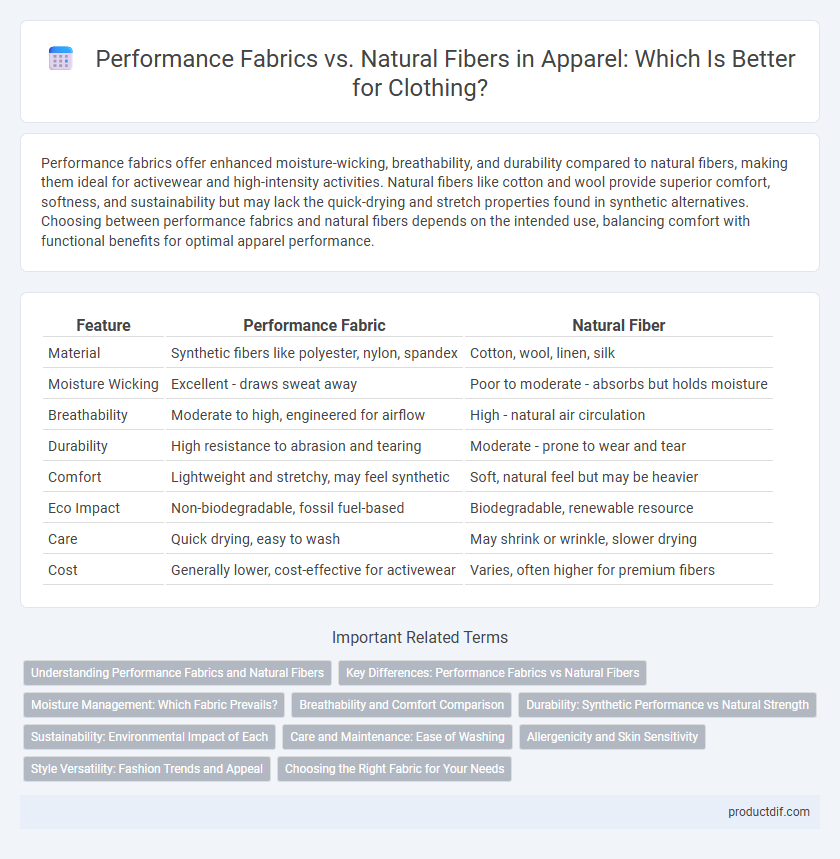Performance fabrics offer enhanced moisture-wicking, breathability, and durability compared to natural fibers, making them ideal for activewear and high-intensity activities. Natural fibers like cotton and wool provide superior comfort, softness, and sustainability but may lack the quick-drying and stretch properties found in synthetic alternatives. Choosing between performance fabrics and natural fibers depends on the intended use, balancing comfort with functional benefits for optimal apparel performance.
Table of Comparison
| Feature | Performance Fabric | Natural Fiber |
|---|---|---|
| Material | Synthetic fibers like polyester, nylon, spandex | Cotton, wool, linen, silk |
| Moisture Wicking | Excellent - draws sweat away | Poor to moderate - absorbs but holds moisture |
| Breathability | Moderate to high, engineered for airflow | High - natural air circulation |
| Durability | High resistance to abrasion and tearing | Moderate - prone to wear and tear |
| Comfort | Lightweight and stretchy, may feel synthetic | Soft, natural feel but may be heavier |
| Eco Impact | Non-biodegradable, fossil fuel-based | Biodegradable, renewable resource |
| Care | Quick drying, easy to wash | May shrink or wrinkle, slower drying |
| Cost | Generally lower, cost-effective for activewear | Varies, often higher for premium fibers |
Understanding Performance Fabrics and Natural Fibers
Performance fabrics, engineered with synthetic fibers like polyester and nylon, offer superior moisture-wicking, durability, and stretch, making them ideal for activewear and outdoor apparel. Natural fibers such as cotton, wool, and linen provide breathability, comfort, and biodegradability, favored for casual and everyday clothing. Understanding the distinct qualities of these materials helps consumers choose apparel based on activity, comfort needs, and environmental considerations.
Key Differences: Performance Fabrics vs Natural Fibers
Performance fabrics, often made from synthetic materials like polyester and nylon, provide superior moisture-wicking, durability, and stretch compared to natural fibers such as cotton and wool, which offer breathability and comfort. Natural fibers excel in temperature regulation and biodegradability, while performance fabrics dominate in resistance to wear, quick drying, and enhanced flexibility. The key difference lies in the balance between comfort and advanced functionality, with performance fabrics engineered for active use and natural fibers favored for everyday wear and sustainability.
Moisture Management: Which Fabric Prevails?
Performance fabrics excel in moisture management by utilizing advanced synthetic fibers such as polyester and nylon, which wick sweat away from the skin and dry rapidly, enhancing comfort during physical activity. Natural fibers like cotton absorb moisture but retain it longer, often leading to dampness and chafing in high-intensity conditions. Moisture-wicking technology embedded in performance fabrics ensures superior breathability and quick-drying properties, making them the preferred choice for activewear and sports apparel.
Breathability and Comfort Comparison
Performance fabrics, often made from synthetic materials like polyester and nylon, excel in moisture-wicking and quick-drying properties, enhancing breathability during intense physical activities. Natural fibers such as cotton and wool offer superior comfort due to their softness and ability to regulate temperature, but they tend to retain moisture longer, which can reduce breathability. Choosing between performance fabric and natural fiber depends on the balance between active breathability needs and overall comfort preferences.
Durability: Synthetic Performance vs Natural Strength
Performance fabrics crafted from synthetic fibers such as polyester and nylon exhibit superior durability due to their resistance to abrasion, moisture, and stretching compared to natural fibers like cotton and wool. These engineered materials maintain their structural integrity after repeated wear and washing, making them ideal for activewear and outdoor apparel. Natural fibers offer natural strength but tend to degrade faster under harsh environmental conditions, leading to shorter garment lifespan in performance contexts.
Sustainability: Environmental Impact of Each
Performance fabrics often utilize synthetic fibers such as polyester and nylon, which are derived from petrochemicals and involve energy-intensive production processes that contribute to higher carbon emissions and microplastic pollution. Natural fibers like organic cotton, hemp, and wool generally have a lower carbon footprint, are biodegradable, and support soil health through sustainable farming practices, though their water and land use impact varies by crop. Evaluating the environmental impact of apparel materials requires considering factors such as lifecycle emissions, biodegradability, resource consumption, and potential for recycling or composting to ensure true sustainability.
Care and Maintenance: Ease of Washing
Performance fabrics offer superior ease of washing compared to natural fibers, as they typically resist stains, moisture, and wrinkles, allowing for quick machine washes without special detergents. Natural fibers like cotton and wool require more delicate care, including cold water cycles, gentle detergents, and air drying to prevent shrinkage and fabric damage. The durability of performance fabrics supports frequent washing and quick drying, making them ideal for active lifestyles and low-maintenance apparel care.
Allergenicity and Skin Sensitivity
Performance fabrics often feature synthetic fibers like polyester and nylon that are engineered for moisture-wicking and durability but can cause higher allergenicity in sensitive skin due to chemical treatments and finishes. Natural fibers such as cotton, wool, and bamboo are hypoallergenic and breathable, reducing skin irritation and promoting comfort for those with skin sensitivities. Choosing apparel with natural fibers or performance fabrics labeled hypoallergenic helps minimize allergic reactions and enhances overall skin health.
Style Versatility: Fashion Trends and Appeal
Performance fabrics showcase unparalleled style versatility by adapting to contemporary fashion trends while maintaining functionality, making them ideal for active and lifestyle apparel. Natural fibers, such as cotton and wool, offer timeless appeal and breathability, favored in classic and eco-conscious fashion circles. The fusion of performance fabrics with natural fibers is increasingly popular, blending durability with aesthetic sophistication to meet diverse consumer demands.
Choosing the Right Fabric for Your Needs
Performance fabrics offer superior moisture-wicking, durability, and stretch compared to natural fibers, making them ideal for activewear and high-intensity activities. Natural fibers like cotton and wool provide breathability and comfort, excelling in casual and everyday apparel for sensitive skin users. Selecting the right fabric hinges on balancing activity level, environmental conditions, and personal comfort preferences to achieve optimal performance and wearability.
Performance fabric vs natural fiber Infographic

 productdif.com
productdif.com